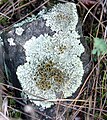Xanthoparmelia
| Xanthoparmelia | |
|---|---|

| |
| Xanthoparmelia conspersa | |
| Scientific classification | |
| Domain: | Eukaryota |
| Kingdom: | Fungi |
| Division: | Ascomycota |
| Class: | Lecanoromycetes |
| Order: | Lecanorales |
| Family: | Parmeliaceae |
| Genus: | Xanthoparmelia ( Vain.) Hale (1974)
|
| Type species | |
Ach.) Hale (1974)
| |
| Synonyms[1] | |
|
List
| |
Xanthoparmelia (commonly known as green rock shields or rock-shield lichens) is a genus of foliose lichen in the family Parmeliaceae.[2][3]: 134 Xanthoparmelia is synonymous with Almbornia, Neofuscelia, Chondropsis, Namakwa, Paraparmelia, and Xanthomaculina.[4] This genus of lichen is commonly found in the United States, as well as Australia, New Zealand and Ecuador.
The name means 'golden yellow parmelia'. The
Identification
Distinguishing between species involves how much they are attached to the substrate, whether or not isidia are present, lower surface color, and chemical spot tests.[3]: 134 All members of the genus react to spot test as K−, KC+ yellow, with medulla reaction varying from species to species.[3]: 134
Species
Species include:
- Xanthoparmelia chlorochroa
- Xanthoparmelia conspersa (Parmelia conspersa)
- Xanthoparmelia cumberlandia
- Xanthoparmelia lavicola - a foliose (leaf-like) lichen found on basalt[5]
- Xanthoparmelia lineola
- Xanthoparmelia maricopensis
- Xanthoparmelia mexicana
- Xanthoparmelia metastrigosa[6]
- Xanthoparmelia mougeotii (Parmelia mougeotii)
- Xanthoparmelia nana
- Xanthoparmelia pokornyi
- Xanthoparmelia subramigera
- Xanthoparmelia scabrosa
- Xanthoparmelia tinctina
Taxonomy
Xanthoparmelia was originally conceived of as a section of the genus Parmelia by Brazilian lichenologist Edvard August Vainio in 1890, to accommodate yellow species with narrow lobes.[7] Mason Hale considered that the combination of traits including the presence of the cortical pigment usnic acid, and the microscopic structure of the upper cortex were sufficient criteria to segregate Xanthoparmelia from the genus Parmelia. He formally transferred 93 species, including the type, Xanthoparmelia conspersa.[8]
In a 2004 study,
Gallery
-
Unidentified Xanthoparmelia sp.
-
Xanthoparmelia subramigera growing on an asphalt shingle roof in Maryland, United States
References
- Species Fungorum. Retrieved 26 November 2021.
- hdl:11577/3440801.
- ^ ISBN 978-0-300-19500-2
- ^ Lumbsch TH, Huhndorf SM. (December 2007). "Outline of Ascomycota – 2007". Myconet. 13. Chicago, USA: The Field Museum, Department of Botany: 1–58. Archived from the original on March 18, 2009.
- ISBN 978-0-85546-095-2.
- ^ Hale Jr, M.E. 1984. New species of Xanthoparmelia (Vain.) Hale (Ascomycotina: Parmeliaceae). Mycotaxon. 20(1):73-79
- ^ Vainio, E. (1890). Lichens of Brazil. Acta Societatis pro Fauna et Flora Fennica (in Latin). Vol. 7. Helsinki: Heredum J. Simelii. p. 60.
- ^ Hale, Mason E. (1974). "Bulbothrix, Parmelina, Relicina, Xanthoparmelia, four new genera in the Parmeliaceae (Lichenes)". Phytologia. 28 (5): 479–490.
- JSTOR 4135563.
- .
- doi:10.1071/SB09055.
- S2CID 83881337.
- S2CID 83922972.



